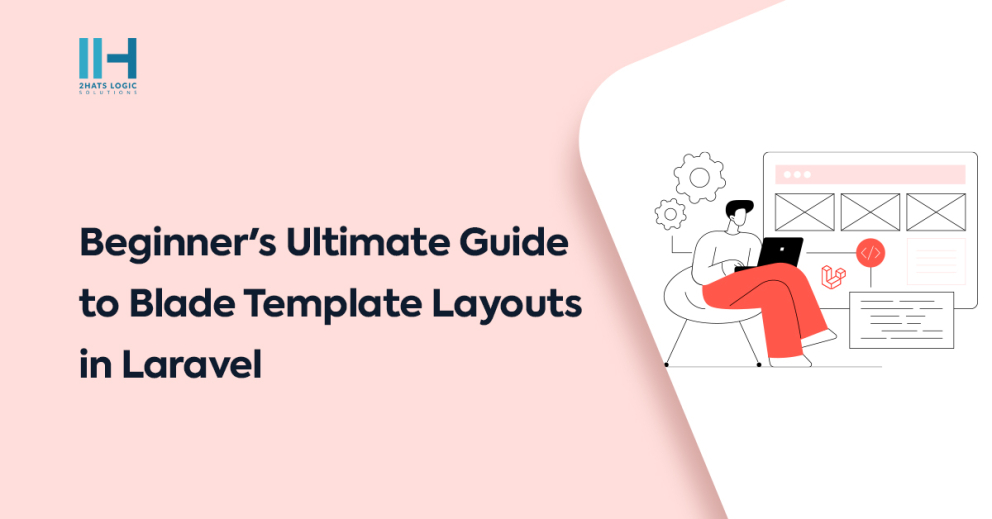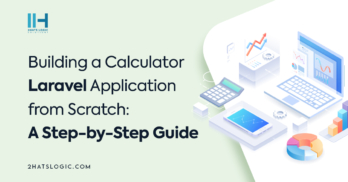Greetings! I'm Aneesh Sreedharan, CEO of 2Hats Logic Solutions. At 2Hats Logic Solutions, we are dedicated to providing technical expertise and resolving your concerns in the world of technology. Our blog page serves as a resource where we share insights and experiences, offering valuable perspectives on your queries.

Blade is Laravel’s templating engine that makes the process of creating dynamic and reusable layouts for your applications easier. Blade enables you to construct layout templates by combining PHP and HTML to create dynamic, easily “maintainable” online applications.
Here, we will walk you through the fundamentals of blade layout, sectioning, templating, and view rendering, all described for beginners.
What is Laravel Blade, and Why Should You Use It?
Blade is Laravel’s templating engine. It is very basic compared to other PHP framework templates and has a straightforward syntactic workflow. To begin with, it allows developers to construct a flexible and compelling web page.
Why Choose Blade?
- Clean Syntax: Write simple, clear templates that are easily maintainable.
- Reusable Layouts: Avoid redundancy by defining layouts and sections you require on many pages.
- Extensibility: Quickly extend or adjust templates to include global changes across the app.
Efficiency: Blade compiles templates into plain PHP to make it efficient.
Basic Blade Template Structure
| 1 2 3 4 5 6 7 8 9 10 11 12 13 14 15 16 17 18 19 20 21 22 23 24 25 26 | <!-- layout.blade.php --> <!DOCTYPE html> <html lang="en"> <head> <meta charset="UTF-8"> <meta name="viewport" content="width=device-width, initial-scale=1.0"> <title>@yield('title', 'Laravel Blade')</title> </head> <body> <div class="container"> @yield('content') </div> </body> </html> |
Key features of Blade Templates
@yield in Laravel’s Blade templating engine is a directive used in the parent layout to specify where content from child views should be injected. It acts as a placeholder. In the child view,
@section is used to define content for specific sections, which is then passed to the corresponding @yield directive in the layout when rendered.
Creating a View Extending the Layout
| 1 2 3 4 5 6 7 8 9 10 11 12 13 14 15 16 17 | <!-- home.blade.php --> @extends('layout') @section('title', 'Home Page') @section('content') <h1>Welcome to the Home Page</h1> <p>This is the content of the home page.</p> @endsection |
- @extends(‘layout’): The location of this line code in the home.blade.php file means that the home.blade.php view extends or inherits the layout.blade.php layout. In other words, the home.blade.php will build its layout from the structure and content of the layout.blade.php.
- @section and @endsection: These directives are used to define sections within the layout that can be filled with specific content from the extending view (home.blade.php in this case).
- @section: Marks the beginning of a section.
@endsection: Marks the end of a section.
Rendering Views and Including Partial Views
You can use the view function to render Blade views from your routes or controllers. Additionally, Blade allows you to include partial views using the @include directive.
Rendering a View
| 1 2 3 4 5 6 7 8 9 | ```php // routes/web.php Route::get('/', function () { return view('home'); }); |
Including a Partial View
| 1 2 3 4 | <!-- layout.blade.php --> <div class="sidebar"> @include('partials.sidebar') </div> |
Benefits of Blade Layouts and Partial Views
- Code Reusability: Understand how to manage headers, footers, and sidebars once and utilize them in views.
- Consistent Design: Ensure that application sections have a consistent structure.
- Simplified Maintenance: For an extended layout, a layout change automatically reflects in all extending views.
- Better Code Organization: Separate layout structure from page-specific logic.
Optimizing Blade Templates for Better Performance
- Enable View Caching: Run php artisan view:cache to cache compiled views for faster rendering.
- Minimize Logic in Views: Keep views clean by processing data in controllers or services.
- Use Blade Components: Create reusable components for commonly used UI elements like buttons or modals.
By following these principles, you can efficiently build and maintain your Laravel application’s performance using Blade.
Conclusion
Blade is a vital tool for Laravel developers, and offers an efficient and clean approach to application’s views. Blade layouts, sections, and partial views enable you to construct highly interactive web pages that are easy to extend and update.
For advanced assistance, consider hiring Laravel developers.
FAQ
What is the purpose of using Blade layouts in Laravel?
Blade layouts in Laravel serve as the foundational structure for web pages, allowing developers to define common elements like headers, footers, and navigation bars in one place. This promotes code reusability, consistency in design, and separation of concerns between presentation and logic.
How do I create a new Blade template layout in Laravel?
To create a new Blade template layout, you can start by creating a `.blade.php` file in the `resources/views/layouts` directory. Within this file, define the basic HTML structure that will be shared across multiple views, including placeholders for dynamic content using `@yield` directives.
Can I customize the layout for specific pages or sections of my Laravel application?
Yes, you can customize the layout for specific pages or sections by extending existing layouts using the `@extends` directive and defining unique content for each section using `@section` and `@endsection` directives. This allows you to maintain a consistent overall structure while accommodating variations in content.
What is the difference between using `@yield` and `@include` in Blade templates?
`@yield` is used to define a placeholder in a layout where content from child views will be injected, whereas `@include` is used to include the content of a partial view directly within another view or layout. While `@yield` is typically used for dynamic content specific to each page, `@include` is useful for reusable components or partials.
How can I render views and include partial views in my Laravel application?
Views can be rendered using the `view` function in routes or controllers, specifying the name of the Blade template to render. Partial views can be included within layouts or other views using the `@include` directive, providing a way to modularize and reuse components across multiple pages.

Related Articles






